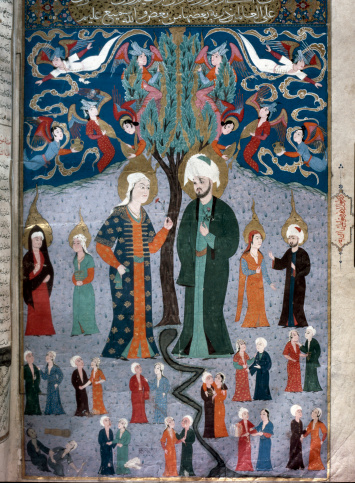
Science in the Qur’ān has no connection with the concept of modern sciences founded upon rational (mathematical) and experimental proofs, and which only emerged for the first time in the 17th century with the dawn of the scientific revolution. Indeed it bears no connection even to the Greek, Roman, Indian, Chinese and Persian sciences.
THESE THEMSELVES were founded upon intuition, opinion and observation and themselves did not meet all the conditions of scientific observation. Moreover, these sciences in Islam are ‘damnable sciences.’ Qur’ānic science is ‘a light that God casts in the heart of the believer’, as Imām Mālik puts it. The ’interloping sciences’ or ‘the sciences of the foreigners’, from medicine to astronomy, logic and philosophy
were not studied in religious education classes given at the universities and madrassas; indeed the Hadīth scholars considered the entry of foreigners’ sciences into the religious sciences a dangerous attack, one that placed the very essence of Islam in danger. Hence the occasional violent reaction against the new methodologies dubbed as ‘damnable heresy,’ since there was no basis for them in the Qur’ān – even if they did not actually stand in open contradiction to the given truths of revelation. Many Muslims, irrespective of denomination, fought against them since, in their view, they were lending weight and influence to the likes of Plato, Aristotle or Galen, more than they were to God’s own Book.[1]
Plus ça change! Their successors continue their ancestors’ war against “the interloping sciences” which “do not accord with God’s Book,” such as modern astronomical cosmology and modern embryology and modern geography. For these fail to accord with Qur’ānic cosmology, embryology or geography, which affirm the existence of seven worlds … and which effectively provides the groundwork for the expulsion of modern sciences “not according with God’s Book.” Given that almost all science fails to accord with God’s Book they have been expelled either from the school system or from the Muslim consciousness through their proscription. Something even more disastrous results upon this: the terrors experienced by a cross-section of young students at the sciences they are studying (even in western universities) in that they are constantly aware that these conflict with ‘scientific’ religious truths.
This accounts for the current disaster of students and professors in Islamic science faculties still believing in the validity of the myths of the Babylonians, myths which were translated by the pens of the Babylonian Captivity from the Legend of Gilgamesh, and in other myths in the Book of Genesis concerning the creation of the universe, by seven gods in seven days, the creation of Adam from clay and the creation of Eve from Adam’s rib (which Freud interpreted as a masturbatory fantasy) and in Noah’s flood, and in Noah’s living to the age of 950 years, and in the sun setting in a well on earth in which there is ‘black clay,’ and in the whole long catalogue of myths which speculating humans have been fashioning for two millenia at least, among all the vast libraries of myths.
Those really responsible for this disaster are not the Islamist movements that stoutly defend them as scientific fact. For these simply performing their role as movements opposing modernity in all its institutions and sciences, and its rational and humane values … Rather it is the education decision-makers who are responsible, people who have failed to offer their schoolchildren and students methods of the standard of educational methods across the globe, even of those in sub-Saharan Africa. There, for example, students learn the principles behind the theory of evolution on the formation of plant and animal life starting from single-cell bacteria in a primitive environment four billion years ago rather than ex nihilo, as the mytho-religious tale has it with its talk of ‘two primal mates’: Adam and Eve.
Religion cannot possibly succeed in forcing science to conform to it
In the same way they study the struggle of human development from an African primate about eight million years ago – a cousin of the chimpanzee which shares 99 per cent of our genetic programming – while the genes of the donkey and the horse are only 96 per cent identical and nevertheless can sire mules. Why can they do this? Because they have both evolved from a common ancestor. These basic truths which are established as a matter of course in the international scientific consciousness still enrage the Muslim scholars of law, who barricade themselves behind the blind certainty of the symbolic Babylonian-Biblical-Qur’ānic tale. In 2000 the Shaykh of al-Azhar issued a verdict prohibiting the printing of any book expounding the theory of evolution following on ‘Abd al-Sābūr Shāhīn’s publication of his book “My father is Adam”![2]
The history of the struggle between faith and science teaches us that religion cannot possibly succeed in forcing science to conform to it, since they belong to two epistemological domains that share no common denominator. The truths of religion are faith-based, fixed and complete, whereas the truths of science are rational, experimental and temporary, and therefore the farthest you could get from complete. They are hypotheses in an endless state of development from the least to the more accurate, and from a limited explanation of some phenomena to a more comprehensive explanation. Thus scientific truth is subject to the rule of development and continuous auto-correction. The history of science gives evidence that human knowledge at any one moment is a collection of competing hypotheses considered to be correct for the moment, then subsequently adjusted according to new hypotheses that explain better a larger number of phenomena and with fewer errors and so on and so forth. Therefore the imposition of Islamic controls over scientific research is a crime against Islam and science alike.

Suggested Reading
The liberation of the collective Islamic consciousness from the obstacle that the Qur’ān is an encyclopædia of science will not be achieved simply by schools refraining from stuffing schoolboys’ and students’ brains with it. For there exists a school without walls made up of 6,000 websites unceasingly targeting the heads of the youth with anti-scientific myths. Rather, it will be achieved when the two viewpoints – both scientific and religious – that deny this myth are taught. Why aren’t paragraphs from this essay included in school curricula? Why aren’t the views taught of those scholars of Islamic law who opposed the ravings of ‘scientific’ interpretation of the Qur’ān. Such views can be found as far back as al-Shātibī[3], who refuted such an interpretation by pointing to the mere fact that the Qur’ān was delivered to illiterate Arabs according to their mental capacity and according to the sciences known in their day, in that
the Sharī‘a is illiterate for its being revealed among illiterate people … and it is not a wise thing that people should be preached things they cannot understand … or be entrusted with things they cannot grasp.[4]
Or consider Bint al-Shātī[5] who believed scientific interpretation of the Qur’ān to be
a disfiguring, concocted obscurantism against the sanctity of faith, and an insult to the logic of modernity and the honour of science.[6]
Bint al-Shati herself refuted a Soviet Orientalist who indicated that there were medical errors in the Qur’ān. What was the problem with that? She argued:
the Qur’ān is not a medical book, it is a spiritual book, is there a single spiritual error in it?”
Or take the Shaykh Mutawallī al-Sha‘rāwī, who wrote that:
those who say that the Qur’ān did not come as a book of science are correct. It was a book that came to teach me about rulings, not about geography, or chemistry or natural science.[7]
Educational decision-makers! How long will you allow Islamic schools to kill the future of your sons before your very eyes?
[1] Muhyī al-Dīn Yahyā, معجم القرآن, pp.803-4.
[2] Shāhīn’s work Abī Ādam – Qussat al-Khalīqa bayn al-Ustūra wal-Haqīqa (‘My Father is Adam, the Story of Creation Between Legend and Truth’) opposes Darwinism, but still runs foul of religious conservatives for having dared to suggest that the Islamic conceptions on creation were influenced by Jewish mythical fantasies and distortions of the true events. (Ed.)
[3] Abū Ishāq al–Shātibī, (ob. 1388), an eminent Islamic legal theorist and author of the famous Al-Muwāfaqāt fī Usūl al-Sharī‘a, that seeks to explain the deeper aims and purposes of Islamic law. (Ed.)
[4] الموافقات, vol.II, pp.69,85,88.
[5] Bint al-Shāti’ (Ā‘isha ‘Abd al-Rahmān) 1913 – 1999, a prolific Egyptian writer, distinguished scholar and vehement defender of the rights of women. She is famous for her social, literary, and Islamic studies. (Ed.)
[6]القرآن والتفسير العصري p.7.
[7] معجزة القرآن p.47.
Main image: Adam and Eve from Seyyid Luqmān ‘Ashūrī’s Zubdat al-Tavārīkh

